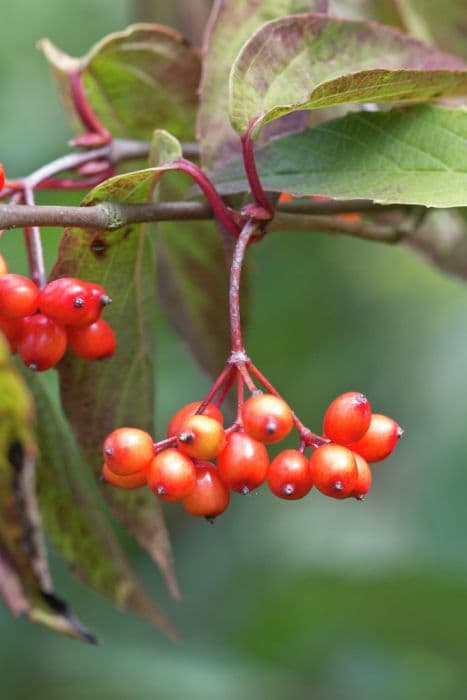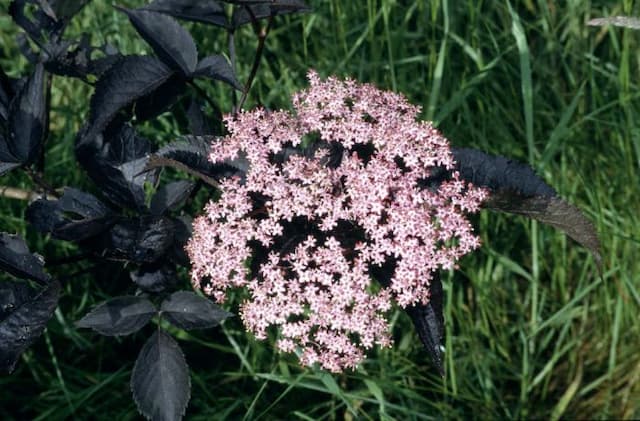Bristly viburnum Viburnum setigerum

ABOUT
V. setigerum is a medium-sized, multi-stemmed, upright to spreading, deciduous shrub to 4m tall. The pointed, ovate-lanceolate to oblong, slightly-toothed leaves are up to 12cm long and change in colour from blue-green to dark-green in spring and summer before taking on attractive autumnal hues. Small white flowers borne in early summer are followed by orange-yellow berries that turn a brilliant red in autumn
About this plant
 Names
NamesFamily
Adoxaceae
Synonyms
Tea Viburnum, Tea Berry Viburnum
Common names
Viburnum setigerum Hance, Viburnum setigerum var. aurantiacum P.S.Hsu & L.M.Gong.
 Characteristics
CharacteristicsLife cycle
Perennials
Foliage type
Deciduous
Color of leaves
Green
Flower color
White
Height
6-10 feet (1.8-3 meters)
Spread
6-10 feet (1.8-3 meters)
Plant type
Shrub
Hardiness zones
5
Native area
China
Benefits
 General Benefits
General Benefits- Aesthetic Appeal: Tea Viburnum offers ornamental value with its attractive foliage and vibrant fruit display which can enhance the visual appeal of a garden.
- Wildlife Attraction: The bright red berries attract various birds and other wildlife, providing a food source and encouraging biodiversity.
- Privacy and Screening: With its dense growth habit, Tea Viburnum can be used for privacy hedges or to screen undesirable views.
- Seasonal Interest: This plant provides year-round interest with flowers in the spring, berries in the autumn, and foliage that may change color in fall.
- Low Maintenance: Once established, Tea Viburnum typically requires minimal care, making it suitable for gardeners of all skill levels.
- Drought Tolerance: The plant can withstand periods of dryness once it is established, reducing the need for frequent watering.
- Versatility in Landscaping: Tea Viburnum can be used in various landscape designs, such as foundation plantings, mixed borders, and as a specimen plant.
- Cold Hardiness: It can tolerate and thrive in cooler climates, expanding the regions where it can be successfully grown.
 Medical Properties
Medical Properties- This plant is not used for medical purposes.
 Air-purifying Qualities
Air-purifying QualitiesThis plant is not specifically known for air purifying qualities.
 Other Uses
Other Uses- Viburnum setigerum, commonly known as Tea Viburnum, can be used as a natural insect repellent when its leaves are crushed and applied to the skin.
- The berries of Tea Viburnum, while not widely known for consumption, can be used to make a wildlife-friendly jam when cooked and properly prepared.
- Tea Viburnum branches can be used in floral arrangements, particularly during the autumn season when the fruit adds a splash of color.
- The dried branches and berries of Tea Viburnum can be used for crafting wreaths and other decorative items.
- Tea Viburnum can be planted as a hedging plant to create natural, living fences that provide seasonal interest and privacy.
- With its dense foliage, Tea Viburnum can be used in garden designs to add texture and layering effects in landscaping.
- As an educational tool, Tea Viburnum can be used in botany classes to study plant morphology and fruit development.
- The plant can serve as a host for butterfly larvae, supporting butterfly conservation and biodiversity in a garden ecosystem.
- Tea Viburnum’s wood can be used in small-scale woodworking projects, such as making handles for garden tools.
- The acidic soil required by Tea Viburnum can be utilized to condition nearby soil, aiding in the growth of other acid-loving plants.
Interesting Facts
 Feng Shui
Feng ShuiThe Tea Viburnum is not used in Feng Shui practice.
 Zodiac Sign Compitability
Zodiac Sign CompitabilityThe Tea Viburnum is not used in astrology practice.
 Plant Symbolism
Plant Symbolism- Renewal: Viburnum setigerum, also known as Tea Viburnum, often symbolizes renewal because it is one of the first shrubs to flower, marking the transition from winter to spring.
- Protection: In some cultures, the robust nature of the Viburnum is thought to represent protection, as it can create dense, protective thickets in the wild.
- Abundance: With its plentiful berries, the Tea Viburnum is often associated with abundance and generosity.
 Water
WaterThe Tea Viburnum should be watered regularly, especially during its first growing season to establish a deep, extensive root system. Once established, they generally require less frequent watering and are quite drought-tolerant. Water the plant deeply rather than frequently, ensuring you moisten the soil down to 8 inches every time you water. During active growth in the spring and summer, watering every week with approximately 1 to 1.5 gallons of water should be sufficient, but make sure to adjust depending on weather conditions and soil drainage. Reduce watering during the winter when the plant is dormant.
 Light
LightThe Tea Viburnum thrives best in full sun to partial shade. It should receive at least 4 to 6 hours of direct sunlight a day for optimal growth and flowering. A location that offers morning sunlight with some afternoon shade is ideal, especially in hotter climates.
 Temperature
TemperatureThe Tea Viburnum is hardy and can tolerate a range of temperatures; it generally prefers an environment between 60°F and 75°F, but can survive minimum temperatures down to about -10°F. The maximum temperature tolerated well by the plant can reach up to 95°F, but it's important to ensure adequate watering during hotter temperatures to prevent stress on the plant.
 Pruning
PruningPruning the Tea Viburnum should be done to maintain its shape, remove dead or weak limbs, and promote healthy growth. The best time to prune is immediately after the plant has finished blooming, usually in late spring or early summer. Pruning too late can remove next year’s flower buds. Remove only older, overgrown branches and any crossing or rubbing limbs to preserve the natural form of the plant.
 Cleaning
CleaningAs needed
 Soil
SoilTea Viburnum thrives in well-draining soil with a pH range of 5.5 to 6.6. A good mix might consist of equal parts loam, peat, and perlite or coarse sand to ensure proper drainage and aeration. Amend the soil with organic matter to boost fertility.
 Repotting
RepottingTea Viburnum typically does not need frequent repotting and can be repotted every 3 to 5 years as it is a slow-growing shrub. Ensure to use the soil mix suited to its pH and drainage requirements when repotting.
 Humidity & Misting
Humidity & MistingTea Viburnum is not particularly humidity-sensitive but does best in moderate humidity. It can adapt to the average outdoor humidity levels in many temperate climates without requiring any special care regarding humidity.
 Suitable locations
Suitable locationsIndoor
Place Tea Viburnum near a bright window; water when soil is dry.
Outdoor
Plant Tea Viburnum in partial shade; water regularly.
Hardiness zone
5-8 USDA
 Life cycle
Life cycleTea Viburnum (Viburnum setigerum) begins its life cycle when a seed germinates, typically in spring, given appropriate conditions of warmth and moisture. The seedling then emerges and develops into a young plant with a basic root system and leaves to start photosynthesis. Over several years, the plant will grow into a mature shrub, with a more extensive root system and woody stems, while continuously producing foliage. Throughout each growing season, usually in late spring, it flowers, producing small white blossoms that offer nectar and pollen to pollinators. Following pollination, the flowers develop into bright red berry-like fruit by late summer or early autumn, attracting birds which aid in seed dispersal. Finally, during the dormant season in winter, growth slows or pauses, allowing the plant to conserve energy and prepare for the next growing season.
 Propogation
PropogationPropogation time
Late winter
Propogation: The most popular method for propagating the Tea Viburnum (Viburnum setigerum) is by semi-hardwood cuttings. This technique is generally performed in late summer. Select healthy, current year's growth and cut a 4 to 6-inch (10 to 15 cm) length, ensuring that there are at least two to three sets of leaves on the cutting. The bottom set of leaves should be removed, and the cut end may be dipped in rooting hormone to encourage root development. The cutting should then be planted in a well-draining soil mix, kept moist, and placed in a warm location with indirect light. Maintaining a humid environment around the cutting by covering it with a plastic bag or a dome can also be beneficial to prevent moisture loss. Roots typically develop in a few weeks, after which the new plant can eventually be potted up or transplanted outside.









